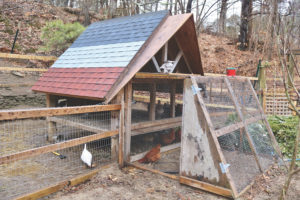The Question: I’d love to build a chicken coop in my yard so we can have fresh eggs, but I’m afraid of rats — not to mention foxes, coyotes, and owls. Is it possible to have chickens without vermin or predators?
Those are serious concerns — believe me, I know from experience. That’s why when I set out to build one at our house, my goal was to create the Alcatraz of chicken coops.

But it’s a small structure, so you want to have some fun with it. My coop design was inspired by A-frame sheds I saw in the Austrian Alps on a trip with my true love.
Mountain houses there are built on stilts, so they stay above the snow drifts. So I built our A-frame coop about two feet off the ground.
As it turned out, that design has two practical advantages when it comes to keeping our Outer Cape chickens safe from unwanted animal visitors: first, the chicken feed stays off the ground, and second, you can keep your eye on what’s happening underneath the coop.
I framed the coop like I was building an actual house, with real rafters and a real roof. A lot of people throw up a plywood box, then are surprised when their chickens become a takeout meal for local wildlife. With heavy duty lumber, the rats and predators can’t chew their way through. I used 6×6 and 2×4 lumber to frame the coop, with 3/4-inch plywood for the flooring and doors. The wood secures the chicken wire against the ground and the other beams, so foxes can’t pry it loose.
In front, a kicker creates the chicken “playground,” a 6-foot by 8-foot space built out of pressure-treated wood boxes that are buried in the ground with chicken wire around them and a plywood overhang. Chickens like taking dirt baths and access to the ground will give you healthier chickens.
A door opens so the chickens can jump out of the coop into the playground. At the end of the day, we can close the door to the playground and the chickens are safe in the coop.
You’ll also want to think about building for your own easy access to the coop. First, remember to build so you can stand up when you’re in the coop cleaning or with the hens. The back of our coop has three trap doors. One opens in the floor so you can use a rake or broom to sweep it clean. The second is long and narrow, a 7-foot by 4-foot door that lifts awning-style to provide access to the four laying boxes. That’s so you can reach in from outside to get the eggs. You don’t need as many brood boxes as you have hens. Even though we have four boxes, they usually end up piling on top of each other in one box. The third door, 3 feet by 2 feet, opens for feeding the chickens. The doors are on rotating pins so they can be secured when not in use.
After some trial and error, this design has proved to be secure — nothing gets in and nothing gets out.
This week’s Dovetail Joint question is answered by Russell Fulcher of Fulcher Construction in Wellfleet. Keep sending your questions and we’ll find more good answers.



